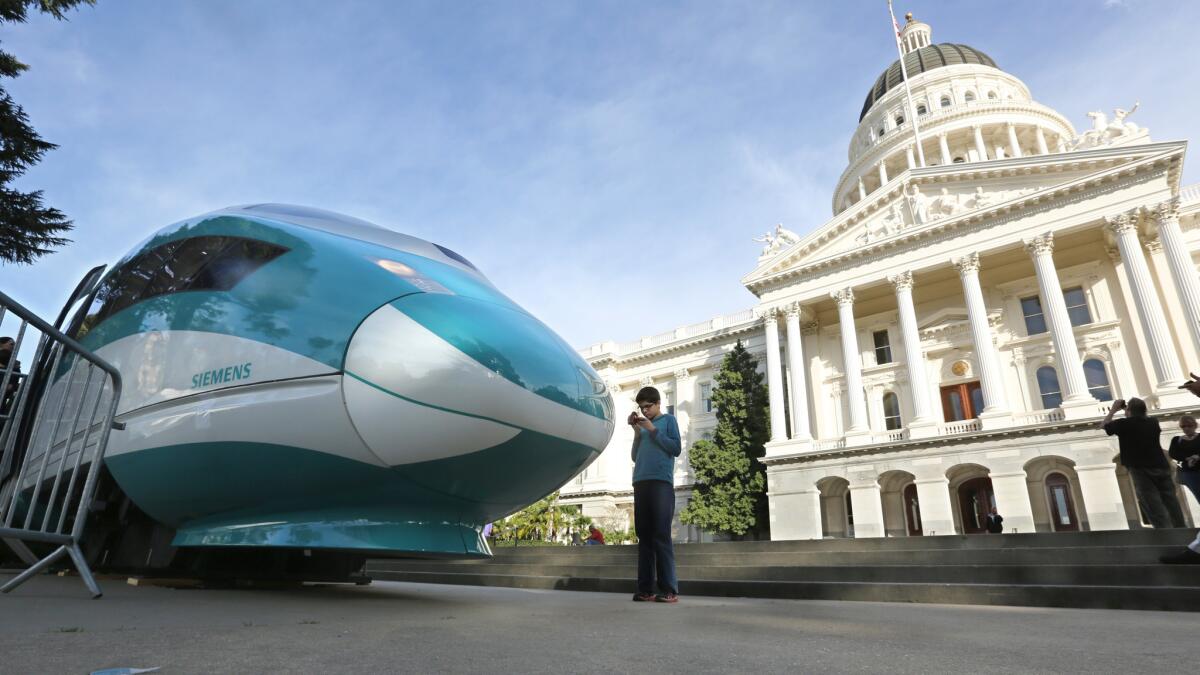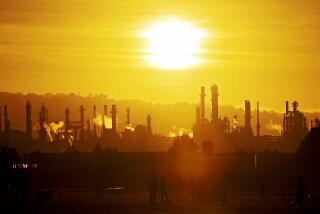California’s cap-and-trade program faces daunting hurdles to avoid collapse

The linchpin of California’s climate change agenda, a program known as cap and trade, has become mired in legal, financial and political troubles that threaten to derail the state’s plans to curb greenhouse gas emissions.
The program has been a symbol of the state’s leadership in the fight against global warming and a key source of funding, most notably for the high-speed rail project connecting San Francisco and Los Angeles.
But the legality of cap and trade is being challenged in court by a business group, and questions are growing about whether state law allows it to operate past 2020. With the end of the legislative session in August, Gov. Jerry Brown, lawmakers and interest groups of all stripes are laying the groundwork for what could become a battle royal over the future of California’s climate change programs.
Unless the state acts, “the whole system could fail,” said Senate leader Kevin de León (D-Los Angeles). “If that happens, we could lose an entire stream of revenue to make our communities more sustainable.”
California received an unwelcome reminder of cap and trade’s precarious situation last month.
The program functions by capping how much greenhouse gas can be emitted into the atmosphere and requiring companies to obtain permits, each allowing 1 metric ton of emissions. Those permits can be purchased at auctions or traded in a market, a system intended to provide a financial incentive for businesses such as power plants, oil refineries and manufacturers to reduce emissions.
By selling the permits, the state generates revenue that can be spent on other initiatives that reduce greenhouse-gas emissions, such as weatherizing homes and helping low-income residents buy cleaner cars. The bullet train is the biggest recipient, getting 25% of the cap-and-trade funds.
During the most recent auction in May, only 11% of the permits offered for sale were purchased.
Analysts suggested that legal uncertainty around cap and trade has damaged faith in a system that, like other markets, requires investors’ confidence to operate smoothly. They also said corporations and speculators are holding more permits than currently needed to cover the amount of greenhouse gas emissions in the state, a supply-and-demand problem that has been growing in every auction over the last year and could continue to choke revenue through 2017.
NEWSLETTER:Get political news in your inbox daily »
“The market is clearly in a position of cumulative surplus,” said Harry Horner, an analyst at CaliforniaCarbon.info. He estimated there are 120 million excess permits, three times more than were up for sale at the latest auction.
Hanging in the balance is funding for the country’s largest infrastructure project, the $64-billion bullet train championed by Brown. Two years ago, as the governor struggled to get construction rolling, he turned to cap and trade to plug a shortfall in funding.
The latest auction produced just $2.5 million of the $150 million expected for the project and drove the price of each permit to the minimum set by the state.
If revenue remains weak, the bullet train could run out of money needed next year to match a federal grant. The state rail authority is depending on annual cap-and-trade revenue of $500 million to build the first operational segment from San Jose to Shafter, a plan that would probably fall apart if the auctions don’t recover.
Officials at the California Air Resource Board, which runs cap and trade, caution against jumping to conclusions that their system is facing major problems.
“One auction doesn’t tell you a lot about the supply and demand over a longer period of time,” said Michael Gibbs, a senior board official.
But there are still uncertainties in the market because companies were encouraged to build up a surplus of permits and no one is entirely sure how many they will ultimately need.
Frank Wolak, a Stanford University economist who has advised the state, suggested an optimistic scenario — polluters might be cutting their emissions more than was expected and don’t need as many permits.
“To the extent that not all the permits are being sold, that is a success of the program,” he said.
See more of our top stories on Facebook »
Either way, the result is a financial problem. Although the state could tap a $500-million reserve of cap-and-trade funds to keep bullet train construction rolling, it could be hard for the state to show that future revenue will be stable enough to secure bonds, a key part of the plan for financing high-speed rail.
Meanwhile, clean energy businesses and environmental justice groups are counting on cap and trade to provide financial support for their products and their communities. And advocates want to ensure California maintains its reputation as a global leader on climate change.
“Now is a critical time to steady the ship,” said Alex Jackson, a San Francisco-based lawyer for the Natural Resources Defense Council. “There is no reason to jump ship, but the headwinds around the program show there’s a lot of uncertainty.”
One of the people with the most at stake is Brown, who has made fighting global warming central to his political mission. But he has not detailed how he wants to handle the situation apart from a statement from his spokeswoman on Wednesday expressing support for a new law extending the state’s climate goals and safeguarding the cap-and-trade program.
If we cease to have [cap and trade], that’s going to send a very loud message to the rest of the world and one we may not want to send.
— Stanford law professor Michael Wara
“We’re looking at it very carefully,” Brown said recently. “There’s more than one way to handle it.”
Brown and his allies are hemmed in by political challenges on multiple fronts. There are Democrats skeptical of environmental initiatives because of potential costs for low-income communities, Some Republicans are opposed to increasing costs on businesses and oil companies seeking leverage for loosening other pollution regulations.
At this point, cap and trade “does not have enough legislative constituencies to continue,” said Assemblyman Sebastian Ridley-Thomas (D-Los Angeles).
Much of the debate over the program has focused on funding, reflecting the degree to which cap and trade has been viewed as a revenue generator rather than just a series of environmental regulations.
The cap-and-trade program grew out of a measure signed by Gov. Arnold Schwarzenegger in 2006. The law set goals for reducing greenhouse gas emissions to 1990 levels by 2020.
“The name of the game wasn’t to raise revenues,” said Dean Florez, a former Democratic state senator who is now a member of the Air Resources Board.
But since then, lawmakers and the governor have relied on the program to pay for a broad swath of initiatives, increasing their reliance on the money. Even Republicans who oppose cap and trade have suggested using the funding to repair dilapidated roads.
That revenue is what’s facing a legal assault from the California Chamber of Commerce. The organization filed a lawsuit nearly four years ago arguing that cap and trade was unconstitutional because it functions like a tax, and the law was not passed by a two-thirds majority in the Legislature needed to approve taxes.
State officials have rejected that argument, saying the program falls within their regulatory power. But the lawsuit received new attention this spring when an appeals court issued a series of pointed questions that led some analysts to suggest they’re preparing to rule against the state.
That would be a blow to climate efforts. Officials have urged other governments to join the market, and the program has been closely studied by Chinese leaders who are launching their own effort.
“If we cease to have [cap and trade], that’s going to send a very loud message to the rest of the world and one we may not want to send,” said Michael Wara, a Stanford law professor.
State Sen. Fran Pavley (D-Agoura Hills), who wrote the 2006 law, said she expected cap and trade to survive a legal challenge, like so many other environmental programs before it.
“Every one of these policies have been sued along the way,” she said. “None of them have been successful.”
But there’s also no consensus on whether a new law is needed to extend cap and trade past 2020. The Air Resources Board said it had the authority to keep going, but the legislative counsel’s office disagrees.
Pavley is pushing a new measure to make it clear that lawmakers stand behind cap and trade and the state’s environmental goals, and she has started having conversations about pushing the issue before the end of the legislative session in August.
But to protect the program against legal challenges like the one it’s facing now, lawmakers may need to extend it with a two-thirds vote. Hitting that threshold would require Republican help, not to mention support from business-friendly Democrats.
Getting there would probably require trade-offs — ones that environmentalists don’t want to make.
Oil companies and their allies are angling to use the debate around cap and trade to dispense with a different regulation known as the low-carbon fuel standard, which requires the industry to produce cleaner gasoline.
“This issue opens up a door to try and have those discussions,” said Rob Lapsley, president of the California Business Roundtable, which represents the state’s largest corporations.
If concerns tied to cap and trade continue to snowball, lawmakers could find themselves considering a massive piece of legislation to address all of them at the end of the session.
“That’s where the magicians come out and wave their wands,” said state Sen. Bob Huff (R-San Dimas).
chris.megerian@latimes.com, ralph.vartabedian@latimes.com
Twitter: @chrismegerian, @RVartabedian
ALSO
Race, oil and the environment all play into this L.A. congressional race
Crackdown on archdiocese-owned oil field near USC gets OK, city attorney says
UPDATES:
1:46 p.m., June 14: This article was updated with permit estimate details from analyst Harry Horner.
3:14 p.m., June 15: This article was updated with a comment from Gov. Jerry Brown’s spokeswoman.
This article was originally published at 12:05 a.m. on June 14.
More to Read
Get the L.A. Times Politics newsletter
Deeply reported insights into legislation, politics and policy from Sacramento, Washington and beyond. In your inbox three times per week.
You may occasionally receive promotional content from the Los Angeles Times.








